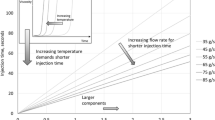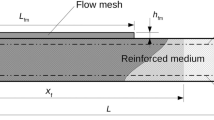Abstract
Resin transfer molding (RTM) is a manufacturing process that uses liquid resin to saturate a fiber preform placed in a closed mold cavity. For robust fabrication of the composite, fiber preform needs to be completely impregnated with polymer resin during mold filling. Hence, the understanding of resin flow and void formation in RTM is very important to design the mold and processing conditions for successful production of composite parts. In this study, three-dimensional (3D) numerical simulation was carried out to investigate the resin flow behavior in a complicated mold. An automotive wheel rim was designed and fabricated using carbon fiber preform and epoxy resin. Case studies were performed to minimize the void formation during processing.
Similar content being viewed by others
References
Bruschke, M.V. and S.G. Advani, 1990, A finite element/control volume approach to mold filling in anisotropic porous media. Polym. Compos. 11, 398–405.
Bruschke, M.V. and S.G. Advani, 1994, A numerical approach to model non-isothermal viscous flow through fibrous media with free surfaces. Int. J. Numer. Methods Fluids 19, 575–603.
Chan, A.W. and S.T. Hwang, 1988, Mold-filling simulations for the injection molding of continuous fiber-reinforced polymer. Polym. Eng. Sci. 28, 333–339.
Chan, A.W. and S.T. Hwang, 1991, Modeling of the impregnation process during resin transfer molding. Polym. Eng. Sci. 31, 1149–1156.
Chan, A.W. and S.T. Hwang, 1992, Modeling nonisothermal impregnation of fibrous media with reactive polymer resin. Polym. Eng. Sci. 32, 310–318.
Chen, J., Y.J. Dong, F.L. Jin, and S.J. Park, 2019, Flexural properties and electrical conductivity of epoxy resin/carbon fiber cloth/metallic powder composites. Macromol. Res. 27, 10–13.
Coulter, J.P. and S.I. Guceri, 1988, Resin impregnation during the manufacturing of composite materials subject to prescribed injection rate. J. Reinf. Plast. Compos. 7, 200–219.
García-Manrique, J.A., R. Hoto, L.I. Gascón, and J. Andrés, 2016, A numerical simulation of woven/anionic polyamide 6 composite part manufacturing using structural reactive injection moulding process. J. Thermoplast. Compos. Mater. 29, 219–233.
Hattabi, M., J. Echaabi, and M.O. Bensalah, 2008, Numerical and experimental analysis of the resin transfer molding process. Korea-Aust. Rheol. J. 20, 7–14.
Hwang, S.H., D.J. Lee, H.R. Youn, Y.S. Song, and J.R. Youn, 2015, Effects of fiber length distribution on flow property and internal microstructure of an injection molded part. Macromol. Res. 23, 844–849.
Isoldi, L.A., C.P. Oliveira, L.A.O. Rocha, J.A. Souza, and S.C. Amico, 2012, Three-dimensional numerical modeling of RTM and LRTM processes. J. Braz. Soc. Mech. Sci. Eng. 34, 105–111.
Kim, B.Y., G.J. Nam, H.S. Ryu, and J.W. Lee, 2000, Optimization of filling process in RTM using genetic algorithm. Korea-Aust. Rheol. J. 12, 83–92.
Laurenzi, S., A. Grilli, M. Pinna, F.D. Nicola, G. Cattaneo, and M. Marchetti, 2014, Process simulation for a large composite aeronautic beam by resin transfer molding. Compos. Pt. B-Eng. 57, 47–55.
Lee, D.J., H. Oh, Y.S. Song, and J.R. Youn, 2012, Analysis of effective elastic modulus for multiphased hybrid composites. Compos. Sci. Technol. 72, 278–283.
Lee, L.J., W.B. Young, and R.J. Lin, 1994, Mold filling and cure modeling of RTM and SRIM processes. Compos. Struct. 27, 109–120.
Li, S. and R. Gauvin, 1991, Numerical analysis of the resin flow in resin transfer molding. J. Reinf. Plast. Compos. 10, 314–327.
Lin, R.J., L.J. Lee, and M.J. Liou, 1993, Mold filling and curing analysis in liquid composite molding. Polym. Compos. 14, 71–81.
Oliveira, I.R., S.C. Amico, J.A. Souza, and A.G.B. de Lima, 2015, Numerical analysis of the resin transfer molding process via PAM-RTM software. Defect Diffus. Forum 365, 88–93.
Patel, N., V. Rohatgi, and L.J. Lee, 1995, Micro scale flow behavior and void formation mechanism during impregnation through a unidirectional stitched fiberglass mat. Polym. Eng. Sci. 35, 837–851.
Poodts, E., G. Minak, L. Mazzocchetti, and L. Giorgini, 2014, Fabrication, process simulation and testing of a thick CFRP component using the RTM process. Compos. Pt. B-Eng. 56, 673–680.
Ruiz, E., V. Achim, S. Soukane, F. Trochu, and J. Bréard, 2006, Optimization of injection flow rate to minimize micro/macrovoids formation in resin transfer molded composites. Compos. Sci. Technol. 66, 475–486.
Shojaei, A., S.R. Ghaffarian, and S.M.H. Karimian, 2003, Modeling and simulation approaches in the resin transfer molding process: A review. Polym. Compos. 24, 525–544.
Trochu, F., R. Gauvin, and D.M. Gao, 1993, Numerical analysis of the resin transfer molding process by the finite element method. Adv. Polym. Technol. 12, 329–342.
Yim, Y.J., K.M. Bae, and S.J. Park, 2018, Influence of oxyfluorination on geometrical pull-out behavior of carbon-fiber-reinforced epoxy matrix composites. Macromol. Res. 26, 794–799.
Yoo, Y.E. and W.I. Lee, 1996, Numerical simulation of the resin transfer mold filling process using the boundary element method. Polym. Compos. 17, 368–374.
Young, W.B., 1994a, Gate location optimization in liquid composite molding using genetic algorithms. J. Compos Mater. 28, 1098–1113.
Young, W.B., 1994b, Three-dimensional nonisothermal mold filling simulations in resin transfer molding. Polym. Compos. 15, 118–127.
Young, W.B., K.H.L.H. Fong, and L.J. Lee,1991a, Flow simulation in molds with preplaced fiber mats. Polym. Compos. 12, 391–403.
Young, W.B., K. Rupel, K. Han, L.J. Lee, and M.J. Liou, 1991b, Analysis of resin injection molding in molds with preplaced fiber mats. II: Numerical simulation and experiments of mold filling. Polym. Compos. 12, 30–38.
Acknowledgements
This work was supported by GRRC program of Gyeonggi Province (GRRC Dankook2016-B03). In addition, this research was supported by Basic Science Research Program through the National Research Foundation of Korea (NRF) funded by the Ministry of Education (2018R1D1A1B07049173) and by the Korea government (MSIT) (No. NRF-2018R1A5A1024127). The authors are grateful for the supports.
Author information
Authors and Affiliations
Corresponding authors
Additional information
Publisher’s Note
Springer Nature remains neutral with regard to jurisdictional claims in published maps and institutional affiliations.
Rights and permissions
About this article
Cite this article
Huang, Z.M., Lee, S.Y., Kim, H.M. et al. Three-dimensional numerical simulation for resin transfer molding of automotive wheel. Korea-Aust. Rheol. J. 31, 141–147 (2019). https://doi.org/10.1007/s13367-019-0015-4
Received:
Revised:
Accepted:
Published:
Issue Date:
DOI: https://doi.org/10.1007/s13367-019-0015-4




